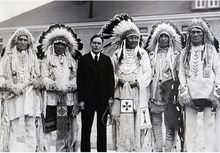Indian Reorganization Act
L'Indian Reorganization Act est une loi fédérale des États-Unis entrée en vigueur le qui met fin au processus de parcellisation des terres amérindiennes introduit par le General Allotment Act de 1887, et reconnaît aux tribus amérindiennes le droit à l'autonomie.

Annexes
modifierBibliographie
modifier- (en) Henry F. Dobyns, « The Indian Reorganization Act and Federal Withdrawal », Applied Anthropology, vol. 7, no 2, , p. 35-44 (JSTOR 44135172).
- (en) Lawrence C. Kelly, « The Indian Reorganization Act : the Dream and the Reality », Pacific Historical Review, vol. 44, no 3, , p. 291-312 (DOI 10.2307/3638029, JSTOR 3638029).
- (en) Scudder Mekeel, « An Appraisal of the Indian Reorganization Act », American Anthropologist, vol. 46, no 2, , p. 209-217 (JSTOR 663080).
- (en) Elmer R. Rusco, A Fateful Time : the Background and Legislative History of the Indian Reorganization Act, University of Nevada Press, , 363 p..
- (en) Graham D. Taylor, The New Deal and American Indian Tribalism : the Administration of the Indian Reorganization Act , 1934-45, Lincoln, University of Nebraska Press, (ISBN 0-8032-9446-8).
- (en) Wilcomb E. Washburn, « A Fifty-Year Perspective on the Indian Reorganization Act », American Anthropologist, vol. 86, no 2, , p. 279-289 (JSTOR 678961).
- (en) « Tribal Self-Government and the Indian Reorganization Act of 1934 », Michigan Law Review, vol. 70, no 5, , p. 955-986 (DOI 10.2307/1287800, JSTOR 1287800).
Lien externe
modifier- (en) Texte de l'Indian Reorganization Act[PDF]